Maxim Panov
Mohamed bin Zayed University of Artificial Intelligence
Uncertainty Quantification for Regression using Proper Scoring Rules
Sep 30, 2025
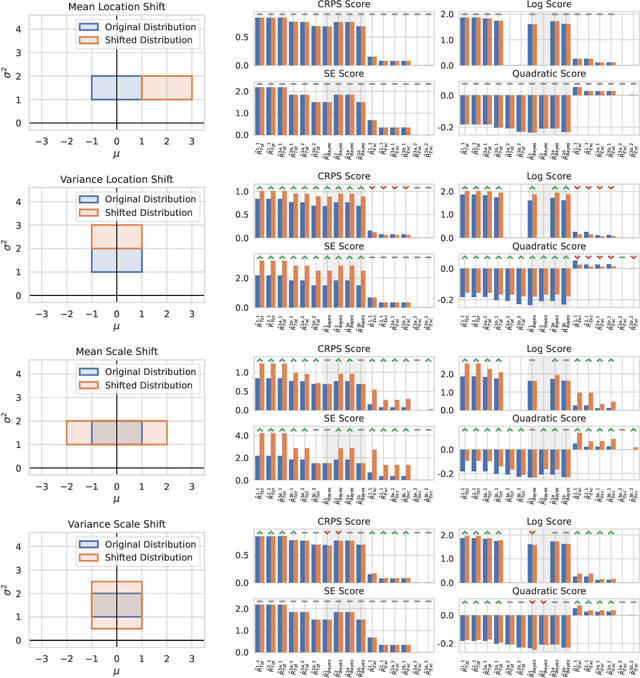


Abstract:Quantifying uncertainty of machine learning model predictions is essential for reliable decision-making, especially in safety-critical applications. Recently, uncertainty quantification (UQ) theory has advanced significantly, building on a firm basis of learning with proper scoring rules. However, these advances were focused on classification, while extending these ideas to regression remains challenging. In this work, we introduce a unified UQ framework for regression based on proper scoring rules, such as CRPS, logarithmic, squared error, and quadratic scores. We derive closed-form expressions for the resulting uncertainty measures under practical parametric assumptions and show how to estimate them using ensembles of models. In particular, the derived uncertainty measures naturally decompose into aleatoric and epistemic components. The framework recovers popular regression UQ measures based on predictive variance and differential entropy. Our broad evaluation on synthetic and real-world regression datasets provides guidance for selecting reliable UQ measures.
Who to Trust? Aggregating Client Knowledge in Logit-Based Federated Learning
Sep 18, 2025Abstract:Federated learning (FL) usually shares model weights or gradients, which is costly for large models. Logit-based FL reduces this cost by sharing only logits computed on a public proxy dataset. However, aggregating information from heterogeneous clients is still challenging. This paper studies this problem, introduces and compares three logit aggregation methods: simple averaging, uncertainty-weighted averaging, and a learned meta-aggregator. Evaluated on MNIST and CIFAR-10, these methods reduce communication overhead, improve robustness under non-IID data, and achieve accuracy competitive with centralized training.
Faithfulness-Aware Uncertainty Quantification for Fact-Checking the Output of Retrieval Augmented Generation
May 28, 2025Abstract:Large Language Models (LLMs) enhanced with external knowledge retrieval, an approach known as Retrieval-Augmented Generation (RAG), have shown strong performance in open-domain question answering. However, RAG systems remain susceptible to hallucinations: factually incorrect outputs that may arise either from inconsistencies in the model's internal knowledge or incorrect use of the retrieved context. Existing approaches often conflate factuality with faithfulness to the retrieved context, misclassifying factually correct statements as hallucinations if they are not directly supported by the retrieval. In this paper, we introduce FRANQ (Faithfulness-based Retrieval Augmented UNcertainty Quantification), a novel method for hallucination detection in RAG outputs. FRANQ applies different Uncertainty Quantification (UQ) techniques to estimate factuality based on whether a statement is faithful to the retrieved context or not. To evaluate FRANQ and other UQ techniques for RAG, we present a new long-form Question Answering (QA) dataset annotated for both factuality and faithfulness, combining automated labeling with manual validation of challenging examples. Extensive experiments on long- and short-form QA across multiple datasets and LLMs show that FRANQ achieves more accurate detection of factual errors in RAG-generated responses compared to existing methods.
Uncertainty-Aware Attention Heads: Efficient Unsupervised Uncertainty Quantification for LLMs
May 26, 2025Abstract:Large language models (LLMs) exhibit impressive fluency, but often produce critical errors known as "hallucinations". Uncertainty quantification (UQ) methods are a promising tool for coping with this fundamental shortcoming. Yet, existing UQ methods face challenges such as high computational overhead or reliance on supervised learning. Here, we aim to bridge this gap. In particular, we propose RAUQ (Recurrent Attention-based Uncertainty Quantification), an unsupervised approach that leverages intrinsic attention patterns in transformers to detect hallucinations efficiently. By analyzing attention weights, we identified a peculiar pattern: drops in attention to preceding tokens are systematically observed during incorrect generations for certain "uncertainty-aware" heads. RAUQ automatically selects such heads, recurrently aggregates their attention weights and token-level confidences, and computes sequence-level uncertainty scores in a single forward pass. Experiments across 4 LLMs and 12 question answering, summarization, and translation tasks demonstrate that RAUQ yields excellent results, outperforming state-of-the-art UQ methods using minimal computational overhead (<1% latency). Moreover, it requires no task-specific labels and no careful hyperparameter tuning, offering plug-and-play real-time hallucination detection in white-box LLMs.
UNCERTAINTY-LINE: Length-Invariant Estimation of Uncertainty for Large Language Models
May 25, 2025Abstract:Large Language Models (LLMs) have become indispensable tools across various applications, making it more important than ever to ensure the quality and the trustworthiness of their outputs. This has led to growing interest in uncertainty quantification (UQ) methods for assessing the reliability of LLM outputs. Many existing UQ techniques rely on token probabilities, which inadvertently introduces a bias with respect to the length of the output. While some methods attempt to account for this, we demonstrate that such biases persist even in length-normalized approaches. To address the problem, here we propose UNCERTAINTY-LINE: (Length-INvariant Estimation), a simple debiasing procedure that regresses uncertainty scores on output length and uses the residuals as corrected, length-invariant estimates. Our method is post-hoc, model-agnostic, and applicable to a range of UQ measures. Through extensive evaluation on machine translation, summarization, and question-answering tasks, we demonstrate that UNCERTAINTY-LINE: consistently improves over even nominally length-normalized UQ methods uncertainty estimates across multiple metrics and models.
Adaptive Temperature Scaling with Conformal Prediction
May 21, 2025Abstract:Conformal prediction enables the construction of high-coverage prediction sets for any pre-trained model, guaranteeing that the true label lies within the set with a specified probability. However, these sets do not provide probability estimates for individual labels, limiting their practical use. In this paper, we propose, to the best of our knowledge, the first method for assigning calibrated probabilities to elements of a conformal prediction set. Our approach frames this as an adaptive calibration problem, selecting an input-specific temperature parameter to match the desired coverage level. Experiments on several challenging image classification datasets demonstrate that our method maintains coverage guarantees while significantly reducing expected calibration error.
Uncertainty-aware abstention in medical diagnosis based on medical texts
Feb 25, 2025
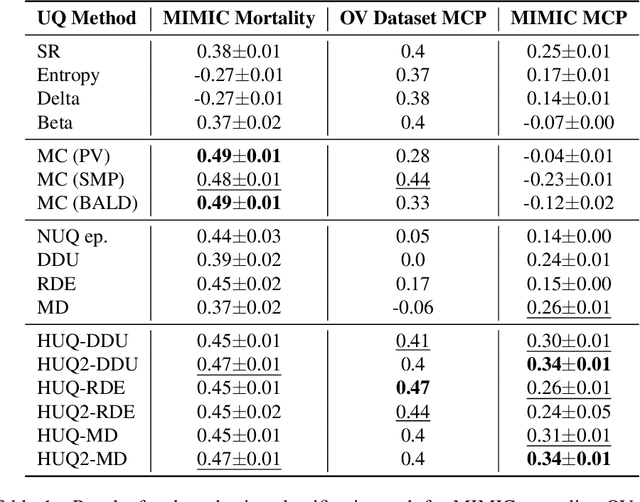
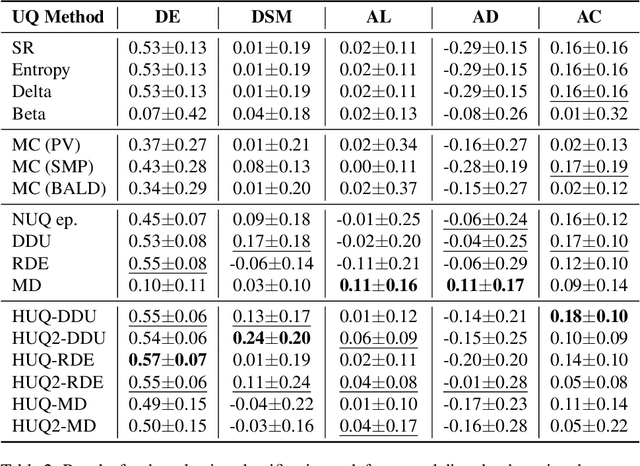
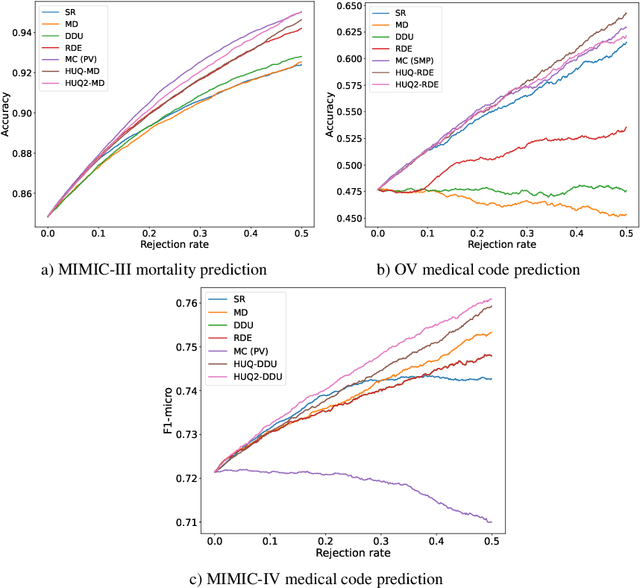
Abstract:This study addresses the critical issue of reliability for AI-assisted medical diagnosis. We focus on the selection prediction approach that allows the diagnosis system to abstain from providing the decision if it is not confident in the diagnosis. Such selective prediction (or abstention) approaches are usually based on the modeling predictive uncertainty of machine learning models involved. This study explores uncertainty quantification in machine learning models for medical text analysis, addressing diverse tasks across multiple datasets. We focus on binary mortality prediction from textual data in MIMIC-III, multi-label medical code prediction using ICD-10 codes from MIMIC-IV, and multi-class classification with a private outpatient visits dataset. Additionally, we analyze mental health datasets targeting depression and anxiety detection, utilizing various text-based sources, such as essays, social media posts, and clinical descriptions. In addition to comparing uncertainty methods, we introduce HUQ-2, a new state-of-the-art method for enhancing reliability in selective prediction tasks. Our results provide a detailed comparison of uncertainty quantification methods. They demonstrate the effectiveness of HUQ-2 in capturing and evaluating uncertainty, paving the way for more reliable and interpretable applications in medical text analysis.
Rectifying Conformity Scores for Better Conditional Coverage
Feb 22, 2025Abstract:We present a new method for generating confidence sets within the split conformal prediction framework. Our method performs a trainable transformation of any given conformity score to improve conditional coverage while ensuring exact marginal coverage. The transformation is based on an estimate of the conditional quantile of conformity scores. The resulting method is particularly beneficial for constructing adaptive confidence sets in multi-output problems where standard conformal quantile regression approaches have limited applicability. We develop a theoretical bound that captures the influence of the accuracy of the quantile estimate on the approximate conditional validity, unlike classical bounds for conformal prediction methods that only offer marginal coverage. We experimentally show that our method is highly adaptive to the local data structure and outperforms existing methods in terms of conditional coverage, improving the reliability of statistical inference in various applications.
Token-Level Density-Based Uncertainty Quantification Methods for Eliciting Truthfulness of Large Language Models
Feb 20, 2025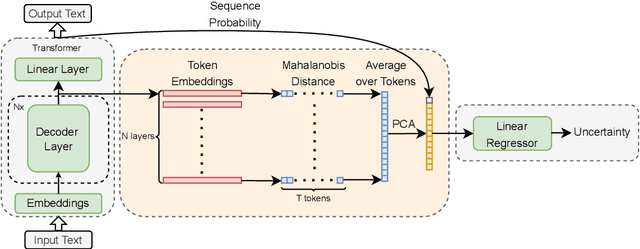



Abstract:Uncertainty quantification (UQ) is a prominent approach for eliciting truthful answers from large language models (LLMs). To date, information-based and consistency-based UQ have been the dominant UQ methods for text generation via LLMs. Density-based methods, despite being very effective for UQ in text classification with encoder-based models, have not been very successful with generative LLMs. In this work, we adapt Mahalanobis Distance (MD) - a well-established UQ technique in classification tasks - for text generation and introduce a new supervised UQ method. Our method extracts token embeddings from multiple layers of LLMs, computes MD scores for each token, and uses linear regression trained on these features to provide robust uncertainty scores. Through extensive experiments on eleven datasets, we demonstrate that our approach substantially improves over existing UQ methods, providing accurate and computationally efficient uncertainty scores for both sequence-level selective generation and claim-level fact-checking tasks. Our method also exhibits strong generalization to out-of-domain data, making it suitable for a wide range of LLM-based applications.
Screener: Self-supervised Pathology Segmentation Model for 3D Medical Images
Feb 12, 2025



Abstract:Accurate segmentation of all pathological findings in 3D medical images remains a significant challenge, as supervised models are limited to detecting only the few pathology classes annotated in existing datasets. To address this, we frame pathology segmentation as an unsupervised visual anomaly segmentation (UVAS) problem, leveraging the inherent rarity of pathological patterns compared to healthy ones. We enhance the existing density-based UVAS framework with two key innovations: (1) dense self-supervised learning (SSL) for feature extraction, eliminating the need for supervised pre-training, and (2) learned, masking-invariant dense features as conditioning variables, replacing hand-crafted positional encodings. Trained on over 30,000 unlabeled 3D CT volumes, our model, Screener, outperforms existing UVAS methods on four large-scale test datasets comprising 1,820 scans with diverse pathologies. Code and pre-trained models will be made publicly available.
 Add to Chrome
Add to Chrome Add to Firefox
Add to Firefox Add to Edge
Add to Edge